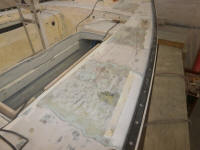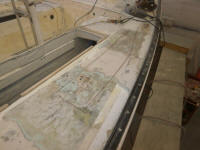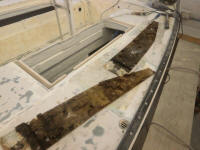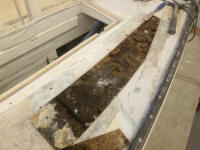
110 Cookson Lane | Whitefield, ME 04353 | 207-232-7600 | tim@lackeysailing.com
Ashantee | Wednesday, January 14, 2015
Now that I'd completed the bulk coatings removal on the deck, I turned to the core repairs required. During earlier stages, I'd earmarked several areas of the deck that sounding and core sampling had suggested would need repair.
I began with the port sidedeck, a long, narrow area outboard of the cockpit. With a saw, I cut through the top skin, conforming roughly to the area I'd marked earlier. On this boat the core ended several inches inboard from the gunwale throughout, and in this particular area it also tapered off at the inboard end, where it met the cockpit coaming, so I kept the cut lines within these bounds. Once I'd completed the cuts, the top skin was easy to pry off in one piece, so damaged was the core within.
Removing the old nasty core from the opening, I soon determined that I'd need--unsurprisingly--to increase the opening at each end, as I'd not yet found sound core at the extent of the first opening. I prefer to start with smaller
openings and expand them as conditions warrant, so with core at the forward end in better condition already, but still showing wetness, I extended the cut forward by several inches, and also aft by a bit, though the way the core tapered off and narrowed here I couldn't go too much further. This exposed sound, clean, dry core at the extents of the cut at the forward end. I reamed out most of the bad core from beneath the edges as needed, though there'd be additional cleanup steps later.
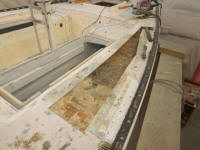
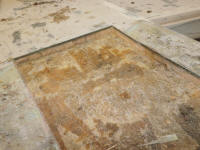

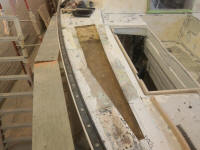
Late in the day, I used an air hose to blow out the edges and clean up the area. The lower skin, which had been damp from the wetness of the core, was already drying off.

I continued to the port side of the poop deck, where testing had shown an area requiring recore. Cutting away the skin, I found that the core became sound by the after end of my cut, but extended inboard at the forward end, following the path of the traveler bolts across the centerline forward of the lazarette hatch. So I found I eventually had to cut away the skin and core from this area as well, towards the starboard side.
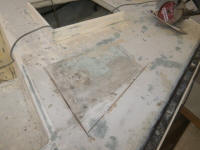
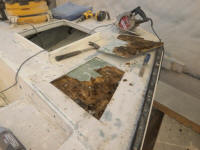
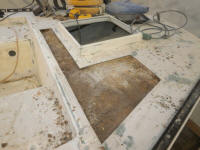
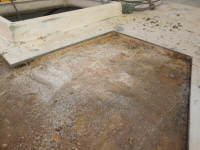
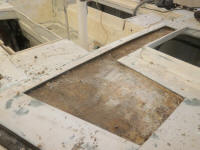
On the starboard side, I began by extending the cut from the centerline towards the outboard end of the traveler bolt holes. The wetness clearly extended significantly aft from this initial cut, so I immediately extended the cut to make the area roughly the same as I'd done on the port side, incorporating all of the large ventilator hole that I'd been intending to patch anyway. Around the hatch opening, the core started to taper almost immediately next to my cut line, so I could easily clean out the remaining core from beneath this lip.
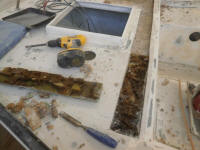
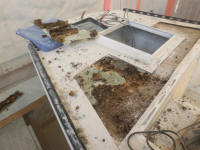
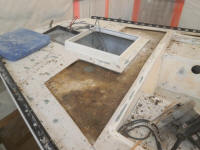
These pictures are from late in the day, following air pressure cleanout.
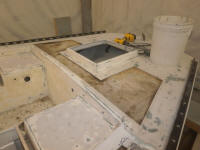
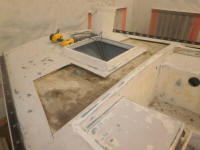
On the starboard sidedeck, given the lessons learned from the areas I'd already uncored, I made the cut over a larger area than I thought I needed, hoping to find good core from the onset. Indeed, in this area the section of damaged core was quite isolated and fairly minimal, confined to an area in the center of the opening beneath where I'd noted the cracks in the deck that led to investigation of the area. With clean, sound core at all edges of my initial cutout, I was soon done with this area.
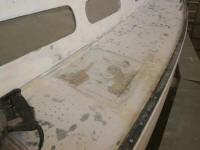
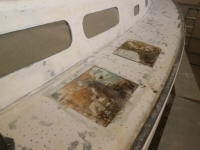
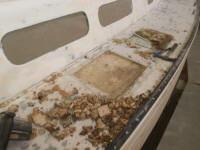
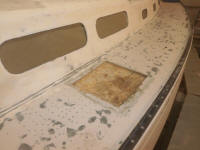
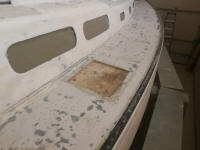
The coachroof had been perhaps the most obvious of the areas requiring this work, as sounding had immediately indicated the ominous dead thump of core rot over most of its area. Still, I wasn't sure exactly how the area was configured, and where the core ended, particularly around the mast step and Dorade boxes.
So I attacked the dismantling in smaller, conservative sections so I could open up only what I needed to. I was not surprised, upon opening the aft section, to find black, horrible core beneath, which I quickly cleaned out. This cutout also taught me a few things about the configuration of this part of the deck, including where the core tapered off to solid 'glass (pretty close to my cutlines in all areas), and also that the Dorade box areas were isolated from the main coring field--something I'd hoped for, actually, as I didn't want to have to cut these boxes away if I could help it.
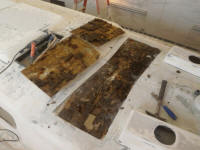
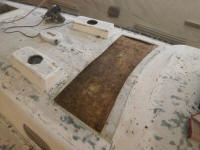
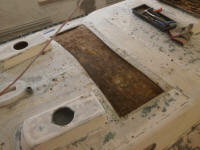

Before continuing, I thought I should make a little template for my own purposes so I could relocate the mast step if disassembly of the remaining deck dictated its removal. I wasn't sure how this step was secured, nor whether it sat above a normally-cored section of the deck or some other structure. Anticipating its removal, the template would allow me to relocate it in the proper place later. I keyed the template off several known locations on the deck for future reference.
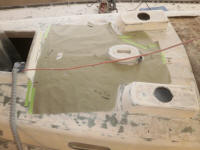
Keeping a consistent distance from the Dorades, and staying clear of the mast step for now, I removed the center aft section, which contained core in such bad condition that it almost didn't exist. I could have wiped the remaining core out with a sponge, so loose, rotten and detached it was.

Now I turned to the forward part and, staying clear of the mast step again, I removed a large athwartships section of the deck. The forward extent of the cut exposed mostly clean core, but later on I extended the cut by about two inches to ensure that I had good core over the whole area.
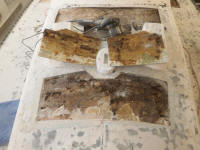
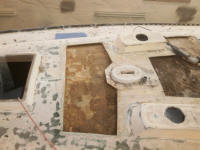
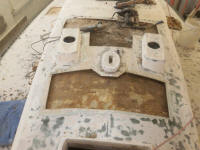
Finally, for now, I connected the two larger areas by cutting narrow strips along the mast step, leaving enough of a flange at the step that I could tie in new fiberglass there if needed (if I didn't end up removing that step), though I expected further investigation later would lead me to remove the step. At the aft end of the step were two countersunk bolt heads, offset slightly to port, which function I did not know but I initially kept my cut away from the bolts, though later I cut closer once I'd determined more about the hidden area beneath.
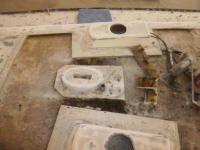
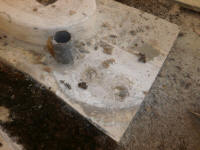
Once I'd extended the cuts as much as I could for the moment, I cleaned out all the core and reamed out beneath all the edge flanges. It might look like I could have cut closer to the Dorade boxes, but actually the core tapered off shortly outboard of my cut lines, an easy reach with my reaming tool.
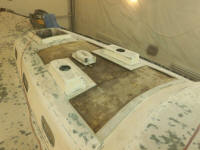
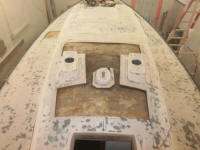

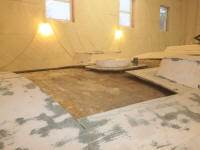
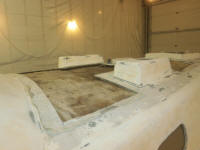
With most of the deck cut away, and core removed, from around the mast step, I could start to see beneath. My reamer seemed to hit something more solid, but maybe not. In any event, I'd determine what I needed to do with the step next time. I'd accomplished my immediate goal of opening all the already-known areas on deck (excepting the cockpit sole, which I'd take care of in due course and which dimensions were known), so I could measure and order replacement materials and keep the project moving along.
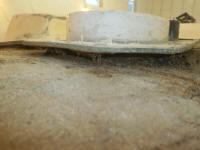
Total Time Billed on This Job Today: 7
Hours
